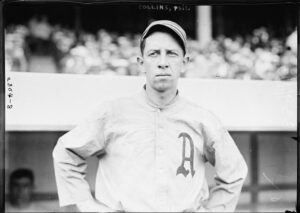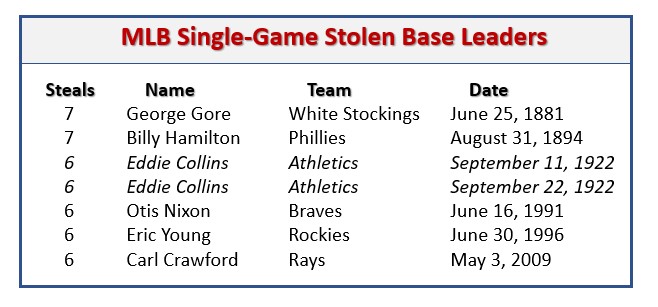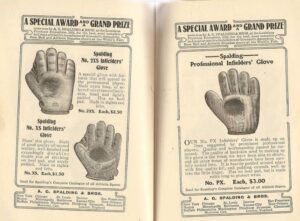As the off-season drags on, Baseball Roundtable continues to randomly peruse the MLB record books. My thoughts often turn to “unbreakable” records. Readers know what I mean, career marks like Cy Young’s 511 wins, Walter Johnson’s 110 career shutouts Nolan Ryan’s 5,714 strikeouts, Rickey Henderson’s 1,406 stolen bases or Barry Bonds’ 688 intentional walks.
In this post, we’ll take a look at another of those seemingly unreachable career marks, Hall of Famer Eddie Collins 512 sacrifice hits (bunts). No one is even within 100 of that total and the current leaders among active players are Clayton Kershaw with 110 and Elvis Andrus with 103. Couple that with the fact that the bunt has fallen into disfavor (perhaps giving way to the three-run home run) as a strategic weapon and you can see why Collins’ mark should continue stand the test of time.
How the Game Has Changed
In 1915, 24 major-league teams (American, National and Federal Leagues) laid down a record 4,441 sacrifice bunts. In 2022, 30 major-league teams (playing a longer schedule) recorded only 390 sacrifice hits (bunts). Looked at in another way, in 1915 fans could expect to see 2.4 sacrifice bunts per game, while in in 2022 those in the ballpark could anticipate seeing one sacrifice bunt ever 6.2 games.
For those who like to know such things, the 2022 leader in sacrifice bunts was the Arizona Diamondbacks with 31. The Braves almost had a perfect (in a way) season, with only one sacrifice bunt. It came off the bat of rookie CF Micheal Harris in the final game of the season (October 4 at Miami). It was in the fourth inning and, after DH William Contreras and 2B Avisail Garcia opened the inning with singles (putting runners on first and second with no outs), Harris sacrificed them to second and third, respectively. The sacrifice, by the way, did not pay off. What followed was a strikeout, intentional walk and another strikeout, with no runs scoring. Roundtable Note: In that 1915 record season, no team had fewer than 120 sacrifice bunts and the White Sox led the way with 270.
Despite his MLB-record 512 career sacrifice bunts, Eddie Collins never led his league in sacrifices.
_____________________________
A Couple of Other Players Who Were Part of Sacrifice Royalty
Ray Chapman, an infielder with the Indians from 1912 to 1920 (when he was fatally injured by a pitch from Carl Mays), holds the record for sacrifice bunts in a single season with 67 in 1917. That season, Chapman hit .302-2-36, with 98 runs scored and 52 stolen bases. Chapman laid down forty or more sacrifices in five of his nine MLB seasons.
George “Mule” Haas – an outfielder/first baseman for the Athletics, White Sox and, very briefly, Pirates … 1925, 1928-38 – led the American League in sacrifice hits six times, including five consecutive seasons (1930-34).
_________________________________
A little more about Collins.
Collins was a graduate of Columbia University, where he played quarterback on the football team and shortstop on the baseball squad. He was considered one of the smartest players in the game – on and off the field. He was also considered one of the most confident (or, as some reported, arrogant) and competitive players in the game (his nickname as “Cocky”); as well as a supportive (but also demanding) teammate and an individual of notable dedication and integrity. Roundtable Note: Collins was a member of the 1919 White Sox team that was involved in he 1919 World Series “Black Sox Scandal,” but reportedly, because of his solid reputation, was not approached by any of the suspected participants.
High Praise from the Georgia Peach and Others
In Joe Posnanski’s book “The Baseball 100,” Posnanski notes that Hall of Famer Ty Cobb once said of Collins, “Not only does he play the game, he thinks it. If anyone tells you he wasn’t the greatest second baseball of all time, you argue with him”.
Hall of Famer John McGraw on Eddie Collins … from “Collins Revered as One of the Game’s Best Second Basemen,” by Bill Francis, included in the Baseball Hall of Fame “Hall of Famer Facts Series.” “He (Collins) is a steady and brilliant fielder, getting balls that no other second baseman would try for. He is also one of the fastest thinkers I have ever watched, judging plays and executing them with great accuracy … Collins is not playing for individual glory, which is what I like about him. He is always ready to dump down the bunt when that looks like the play … He is a finished ballplayer of the thinking type, and, to my mind, the greatest the world. “
Also from the Hall of Famer Fact Series, Hall of Famer Connie Mack said of Collins, “I want to point out that he was a great batsman, one of the best players defensively and a daring base runner. Then he topped all these things by being the brainiest player that ever guarded the keystone.”
For those who like the such stats as Wins Above Replacement, Eddie Collins ranks 13th All-time at 124.4. For some comparison, that puts him one spot on the list behind Rogers Hornsby and one ahead of Ted Williams.
Eddie Collins at the Plate
Collins was not just a master at giving himself up (sacrifices) for the team, he was also a master at getting on base. He put up a career .333 average and his 3,315 hits are twelfth all-time. He also is in MLB‘s top-20 all-time in on-base percentage (.424, 14th). In today’s game, can you imagine regularly calling on a hitter with that record for reaching base to lay down even an occasional sacrifice? (It seems even less likely when you consider what Collins could do once he was on base. His 741 stolen bases are eighth all -time.)
A few other Collins all-time rankings: singles – 2,643 (third); triples – 187 (12th); walks – 1,499 (19th); runs scored – 1,821 (18th).
Collins was also about a steady a producer on offense as you can be. Within his .333 career average:
- He hit .333 at home and .332 on the road.
- He hit .334 versus righties and .326 versus southpaws.
- He hit .328 in 34 World Series games.
Collins was also solid in the clutch, hitting .355 with runners in scoring position and ramping up his game in the pressure-filled final months of the annual pennant race (.350 in August and .356 in September/October for his career). Career-wise, Mays was his weakest month – but still over .300 (.314).
Eddie Collins hit .300 or better (actually .308 or higher) in 16 of the 18 seasons in which he played at least 100 games.
A few other tidbits from Collins’ career in the batter’s box.
- While he never won a batting title, he finished second three times and in the top four eight times.
- While he never led the league in hits, he finished in the top four four times;
- While he never led the league in on-base percentage, he finished second tree times and in the top four 12 times.
- He led the league in walks once and finished second five times and in the top four ten times.
- He led the Al in runs scored three times and finished in the top four a total of eight times.
Power was not part of Collins’ game. He hit only 47 home runs in 25 seasons. Notably, he did play 13 of his 25 seasons in the “Dead Ball Era,” generally accepted as ending with Babe Ruth’s 29-homer season in 1919. Collins’ final stat line was ,333-47-1,299, with 1,821 runs scored and 741 stolen bases.
In 1914, Eddie Collins won the Chalmers Award (forerunner to the Most Valuable Player Award). That season, he hit .344-2-85, with 58 steals and a league-lading 122 runs scored.
Eddie Collins on the Bases
Eddie Collins, while not the fastest runner of his time, was one of the game’s best base runners – studying pitchers (especially) and catches intensely.,
As noted, his 741 stolen bases are eighth all-time. He led the league in steals three times, finished the AL’s top four 12 times and swiped 40 or more bases in ten seasons. Note: Collins is also eighth all-time in caught stealing .
Collins is also one of just four players (since 1900) to steal six bases in a game – and the only MLB player to do it twice. And, he accomplished the feat twice in an 11-day span.
Eddie Collins in the Field
Despite leading American League second baseman in fielding percentage nine times and finishing second seven times, Eddie Collins is not even in the top 200 among second basemen with at least 500 games at the keystone sack. (He’s 211th). Then again, take a look at the equipment available as he started his major league career.
Here’s a few stats that reflect his play in the field . Collins is:
- First in career game at second base (2,650), led American League second basemen in games played seven times and was in the top four 17 times;
- Second in career putouts at second base (6,526), led the AL seven times was second six times and in the top four 17 times;
- First in career assists at second base (7,630), led the AL five times and was in the top four 15 times;
- 15th in double plays at second base (1,239), led the AL in five seasons, was second five times and in the top four 17 times.
In, 1938, Eddie Collins – then General Manager of the Red Sox – scouted and signed a slender young outfielder named Ted Williams. Commenting on the signing, Collins is quoted to have said it was an easy decision, “Your Aunt Susan could have picked Teddy out of 1,000 players.”
Primary Resources: Baseball-Reference.com; Baseball-Almanac.com; The Baseball 100, Joe Posnanski, Avid Reader Press, 2021; “The Baseball Legend Who Wore ‘Clean Sox,’” Columbia College Today, Spring 2020, by Thomas Vinciguerra; “Collins Revered as One of Game’s Best Second Basemen,’ Baseball Hall of Fame “Hall of Famer Facts” series, by Bill Francis.
Baseball Roundtable – Blogging Baseball Since 2012.

 Baseball Roundtable is on the Feedspot list of the Top 100 Baseball Blogs. To see the full list, click here.
Baseball Roundtable is on the Feedspot list of the Top 100 Baseball Blogs. To see the full list, click here.
Baseball Roundtable is also on the Anytime Baseball Supply Top 66 Baseball Sites list. For the full list, click here.
I tweet (on X) baseball @DavidBaseballRT
Follow Baseball Roundtable’s Facebook Page here. More baseball commentary; blog post notifications.
Member: Society for American Baseball Research (SABR); Negro Leagues Baseball Museum; The Baseball Reliquary.









